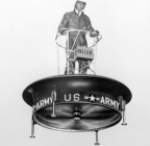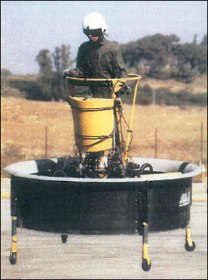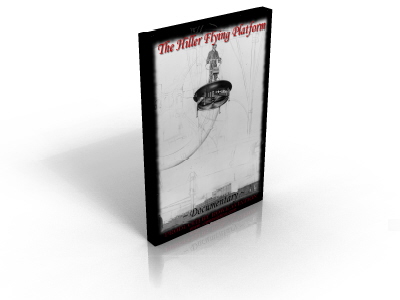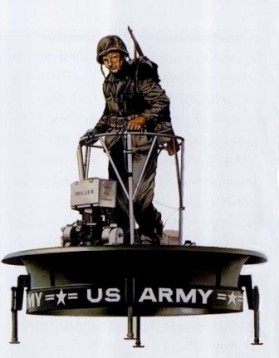The Hiller Flying Platform
Stanley Hiller Junior’s Flying Platform appeared at a time when nuclear, chemical, and biological weapons were proliferating around the world and U.S. Army infantrymen seemed particularly vulnerable to attack. Small, vertical takeoff and landing (VTOL) aircraft appeared to offer the soldiers an ingenious method of escape from these weapons. Hiller founded the Hiller Aircraft Company at the end of World War II specifically to develop innovative approaches to helicopter design. The Hiller Flying Platform is flown by kinesthetic control a term that was coined by Charles Zimmerman.
To control the Flying Platform, the pilot shifted his weight in the direction that he wanted to go. Control of the Flying Platform was also accomplished via the throttle controls of the two engines.
On September 17, 1953, the Office of Naval Research issued a flying platform contract to Hiller Aircraft for what became the Model 1031. By September 1954, construction was finished on the Model 1031. Hiller’s chief test pilot, Philip T. Johnston, made the first test flights. With little to protect the pilot in case of engine failure or loss of control, technicians tethered the flying platform to a high wire suspended between two towers. The Model 1031 proved relatively stable and easy to handle when hovering. In horizontal flight, the vehicle exhibited an automatic, self-righting tendency. This effect made the platform almost impossible to topple. Unfortunately, it also limited the forward speed to a mere 26 kph (16 mph) and caused erratic handling in windy conditions.
Hiller was awarded with a contract to build three Platforms for the Army, however these later designs were not as successful as the original machine. The project was eventually abandoned.

Later on, the concept of a Flying Platform was renewed by the creation of The Hummingbird.
The Hummingbird was built by a man from Israel named Dr. Rafi Yoeli. First flown in 1997, The Hummingbird was controlled in the same way as Hiller’s Flying Platform. This second flying platform has been abandoned too, as research of the designer’s company (Urban Aeronautics) continues in a different direction.
Specifications of the Hiller Flying Platform:
Rotor Diameter: 7 ft
Platform Diameter: 8 ft 4 in
Height: 7 ft
Empty Weight: 370 lbs
Gross Weight: 555 lbs
Engine: (2) Nelson H-59 two-cycle engines, 40 horsepower
Materials:
Duct: fiberglass
Rotor Blades: Aluminum
Operator Platform and frame work: Aluminum
Guide Vanes: Aluminum sheet
Many people have desired to build this magnificent flying carpet. Sadly, there are no plans available from which to build. We hope that changes, but until then, beware if someone tries to sell you plans to the Hiller Flying Platform. Although some people claim they have “plans,” none exist. We do not sell plans to this machine, however with our DVD we include the original patent from the United States Patent Office. It may be possible to build from this patent, as it includes detailed diagrams and descriptive text on how the Flying Platform is constructed, flown, and operated.
Our DVD has COLOR VIDEO footage of the Hiller Flying Platform, as well as footage of The Hummingbird.
Also includes slideshows of the Hiller and Hummingbird Platforms, plus a close-up photo tour of the Hiller Platform on display at Hiller Aviation Museum in Redwood, California.
Also included:
Many pictures of the Hiller machine, the Hummingbird and also pics of Charles Zimmerman’s Flying Shoes.

Case for advertising purposes only. DVD comes in a dust-jacket protective covering.

